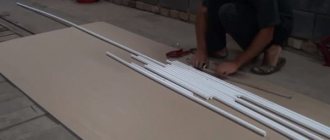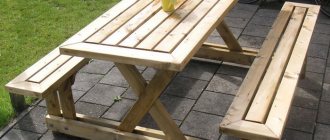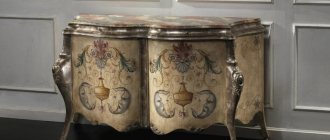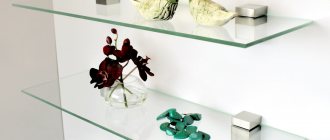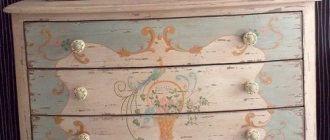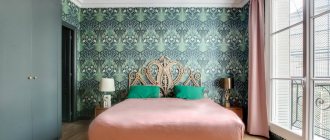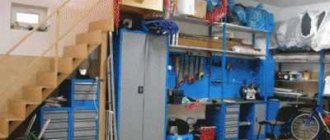A trip to a furniture store or workshop in order to purchase a cabinet can hit your wallet hard. In addition, the furniture may not meet expectations.
A purchase is often unable to accommodate even half of the things, having only seemingly sufficient volume. It’s cheaper and more practical to make a cabinet from furniture panels with your own hands.
Furniture panels lead the list of reliable products with a long service life. Production is based on connecting wooden blocks to each other under pressure. As a result, the wood is glued together under high pressure, forming a monolithic
system. Popular materials are spruce, pine, birch and oak.
Reference
. In addition to the hypoallergenic structure, each part can be easily restored due to the uniformity of the wood in case of damage. In this case, the element is not replaced.
Dimensions and drawing
Before starting work, you need a clear understanding of the cabinet design. It is necessary to first clean the place where it is intended to be assembled. In this case, the purpose of operation is determined. For example, a kitchen cabinet should have a large number of shelves and drawers for storing cutlery, while a dressing room requires additional elements in the form of a hanging rod.
Depending on these factors, the parameters of the future design are determined. Measurements are being taken
space allocated for furniture assembly and transferred to
the drawing
. At the same time, you need to decide on:
- height of mezzanines;
- depth, height and width - parameters that determine the volume of the product;
- number of compartments and doors;
- for internal filling in the bedroom wardrobe, the location of the hanger rod;
- the number and parameters of drawers, as well as the dimensions of shelves and internal partitions (if any).
All elements are reflected in the preliminary sketch. Having experience in creating drawing diagrams will allow you to design the outlines of future furniture on a regular sheet of paper. If these are not available, experts recommend using computer programs or VR applications. If desired and accurately represented, the specified parameters will help create a 3D model on the basis of which the assembly will be carried out.
When creating a new cabinet to replace old furniture, it is possible to use the old drawing as a basis. Any changes should be made before work begins, since cutting additional parts during the process of forming the cabinet becomes impossible.
Reference
. On the Internet you can search for ready-made sketches of a suitable design. All that remains is to substitute the measured parameters and add the necessary compartments.
In the process of creating a drawing, the required material is calculated and details
, cutting is thought out in order to create a minimum of waste. Also, the owner of the premises should think about what size furniture panel will be suitable.
It is possible to build on the parameters of a standard shield 200x60 cm, if free space in the room allows. In this case, the depth will reach 56-57 cm, the width will vary from 1 to 1.8 m according to the number of doors, and the height will be 2 meters.
Important
. After sketching the main elements, you will need to calculate the number of fasteners and fittings.
Materials and accessories
Furniture panels do not emit hazardous components throughout their entire service life, since environmentally friendly wood is used to create them. At the same time, the internal structure remains quite pliable, making it possible to process the material according to individual preferences.
The body and doors (facade) of the furniture are formed from furniture panels.
Its thickness should reach 20 mm. You will also need the following materials
:
- when creating a wardrobe, you must additionally purchase a hanger rod or clothes hooks;
- holders and fastening systems (screws, door hinges, handles, locks) for attaching the facade to the sides of the cabinet.
It is important to calculate in advance the approximate number of small parts. When purchasing on the construction market, fasteners are purchased with a reserve of 10-20% of the required quantity; - drawers will require the purchase of plywood with a thickness of 6 mm;
- the back wall is usually made of thin flexible materials. For this purpose, a sheet of hardboard (fibreboard) or sanded plywood with a thickness of 4 mm is suitable;
- To form vertical internal partitions and shelves, it is recommended to use 12 mm plywood. This is necessary in order to save money. A structure made only from furniture panels will cost much more.
In the standard design, the bottom of the structure is installed between the side walls, while the cabinet lid is placed on top of the sides. Consequently, the width of the lid exceeds the width of the bottom by 35-40 mm. In this case, the upper part of the cabinet can protrude beyond the doors as a canopy. In this case, it is necessary to calculate the height of the doors in advance. If there is a plinth, the doors should be shorter than the side ones by its height.
If there are drawers at the bottom of the cabinet, it is important to remember that they are not covered by the front. In this case, the length of the cabinet doors is adjusted.
Important
. The depth of the shelves should be less than the depth of the cabinet itself.
Tools
It is recommended to take care of preparing the necessary tools
:
- centimeter tape and pencil for creating markings;
- varnish for wooden products;
- chisel;
- electric drill with various attachments;
- hacksaw for working with wood;
- screws and metal profiles;
- screwdriver;
- grinding apparatus.
Reference
. It is not advisable to purchase this set of tools for one-time use. It is more practical to rent for the duration of work.
Where to begin
A home craftsman who decides to assemble his own furniture board should take care to have on hand:
- belt and surface grinder (you can use sandpaper screwed onto the block, but this will lengthen the process);
- clamps or homemade devices for tightening boards;
- plywood and thin slats for holding the lamellas together;
- tool for measuring length;
- thicknesser stand with clamp;
- milling machine;
- lumber;
- electric plane;
- circular saw;
- pencil;
- hammer;
- drills;
- glue.
Rice. 1. Blanks for furniture panels
Then you should decide on the dimensions of the future wooden panel. To ensure that the result does not disappoint, follow these recommendations:
- the length and thickness of the workpieces must be greater than the final parameters;
- boards made of only one type of wood are included on a separate sheet;
- You can only use workpieces that are dry and smooth, with a minimum number of knots;
- The ratio of width to thickness for lamellas (unjoined pieces) is taken as 3x1 (the internal tension of the wood with such an aspect ratio is not enough to split the slats).
Rice. 2. Furniture panel
It is necessary to take into account that during drying, wood warps in different directions. It occurs most intensely in the tangential direction (along the tree rings), and is 2 times weaker in the radial direction (along the core lines).
Rice. 3. a) the core is connected to the core; b) the sapwood (the outer layer immediately below the bark) is bonded to the sapwood; c) and d) we use blanks with curling noticeable to the naked eye (random arrangement of wood fibers), we orient them along the lines of annual rings.
Division into classes
As previously mentioned, there is no single GOST regarding the parameters of furniture panels. Each manufacturer, based on the existing standards GOST 8486-86 and GOST 2140-81, has the right to establish its own technical production conditions. Conventionally, furniture panels, regardless of the material, are divided into 4 classes, which can also be called grades;
- C class or Economy - a lamella or spliced type panel with small defects that do not have a significant effect on the overall mechanical properties of the product. These may be small spots, cracks, knots. Suitable for subsequent veneering and lamination;
- To class - allows only healthy knots to be present on the canvas. Made by splicing lamellas. They do not select textures and shades based on pattern;
- And the class is a spliced shield made of lamellas of the “spike” type. Knots and other wood defects must be absent. Uniformity of tone and character of the pattern are important;
- Extra class - a solid-lamella type shield, without defects and knots. Lamels are selected according to color, tone, texture.
Division into classes
- Furniture
is a modern, eco-friendly, durable material that is used not only for the production of furniture (including children’s) and its elements (frames, walls, shelves, wardrobes), steps, tabletops, window sills, but also for finishing premises. - Made from natural spliced lamellas. Due to the many layers of lamellas glued in different directions, the material is durable, does not deform or crack.
- Furniture board is an environmentally friendly analogue of chipboard. Unlike chipboard, for the production of which formaldehyde resins are used, furniture board is durable and retains the properties of wood with minimal use of glue. It can be made from almost any type of wood.
- Furniture panels can be solid-lamella (made of solid lamellas without joints along the length) and spliced (with joined lamellas along the length). The lamellas are spliced along their length using a tenon joint. The spike can be visible from above (“herringbone”) or from the side (then an even joint is visible from above).
| view from above | side view (edge) | |
| open herringbone spike | The herringbone spike is stronger and smoothes out the color difference between the lamellas | straight joint on the side |
| closed tenon | smooth joint at top | herringbone spike on the side |
Blank gluing technology
To minimize warping during drying, we select and lay next to each other boards with an optimally similar arrangement of annual rings. We mark them in any noticeable way, for example, by drawing a figure. Then, this will help you not waste time searching for the required lamella (unjointed workpiece). The ends of the workpieces must be smoothed before gluing.
Further procedure:
- Place the lamellas in a pack, coat the ends with glue (blanks placed in a plastic bag stick together more slowly).
- We tighten the glued wood with large clamps. You can use a clamp (a device assembled from scraps of blanks). The tightening moment is achieved by wedges driven between the stop and the end of the lamella. Or clamp boards between metal shelving brackets. The principle is the same - adhesion along the edges is made using wooden blocks and wedges.
- Thorough drying of the woven fabric. To make the surface even and smooth, plan the shield, sand it and remove excess glue.
Rice. 4. Slat joining
Rice. 5. Connecting wooden elements
It is permissible to use different methods of connecting lamellas. A shield made without glue can provide a powerful interface. To understand this, explore the options illustrated below.
Rice. 6. Furniture panels
An example of furniture made from panel furniture, assembled with your own hands, can be a table for working at a computer. To install this multifunctional, compact product, you will need:
- 3 shields with dimensions 2000x600x18 mm;
- 3 – 2000x400x18 mm;
- 2 – 2000x200x18 mm;
- edged board 12x120 mm;
- plywood 6 mm;
- dowels.
Rice. 7. You can assemble a computer desk of any size from furniture panels. Choose the color, number of shelves and drawers at your discretion.
Rice. 8. Computer desk: assembly diagram with dimensions
First of all, we draw up drawings, take measurements, then move on to the actual production of the table:
- We “cut” a large shield onto the tabletop, side walls, bottom and top of the cabinet.
- We plan the corners of the sides of the upper outer part, giving them smoothness.
- In the sidewall that will fit tightly to the wall, we make a recess for the baseboard (5x5 mm).
- In the center of the side inside the vertical wall, to achieve the required rigidity, we install a transverse panel. We fix it with self-tapping screws.
- We file off sharp corners and make recesses for the baseboard in the niche that is intended for the system unit.
- We make a frame for shelves placed above the table.
- We attach the frame to the already connected parts.
- We “cut” the middle shield for the top shelf, the small shield will go to the middle partition connected to the tabletop.
- We make a shelf with a jumper from a small board and place it above the cabinet.
- We make pull-out drawers. We make the walls from edged boards, the bottom is made from a sheet of plywood. We connect everything with self-tapping screws.
- We install ball or roller mechanisms for drawers and countertop shelves.
- We cut out the table top for the keyboard from a 40 cm wide board. The scraps can be useful for decorating the outside of the drawers.
- The entire product is disassembled.
- The table elements are processed with a grinding machine.
- All components are coated with 2 layers of varnish.
- After it dries, the final assembly of the entire table is performed.
- We install handles and decorative elements.
No matter how fashion changes, a table made of natural wood in an office, living room or kitchen remains a classic. In most cases, furniture panels are used to produce such furniture. Furniture board is a modern high-quality material.
Production technology
Furniture panels in manufacturing technology are almost no different from the production of other finished wood products. And without going into details and details, natural wood shields are made in the following sequence:
- The standing wood is cut into boards of a certain thickness and thoroughly dried to 8-12% residual moisture.
- The dried lumber is then cut on special automatic cutting lines into lamellas (bars of strictly defined sizes); if the technology provides, then the ends of the wooden bars are cut into slots to create a more durable longitudinal connection.
- The resulting lamellas are assembled using special devices into panels of certain sizes along the length and width, fastening the bars of wood together lengthwise and crosswise. The joints of the bars are pre-treated with an adhesive solution to give the future product such necessary properties as solidity and strength. Next, this assembled wooden structure is compressed on all sides with clamps and left until the glue dries completely for at least two to three days.
- The resulting semi-finished product of future furniture panels does not yet have a smooth surface and correct external dimensions, so the blanks are further processed on universal four-sided machines. Here the workpiece is planed in both planes and trimmed along the edges to the size of the width of the shield, and then it is trimmed to length.
- At the final stage, the finished furniture panels are sorted and, if necessary, the remaining chips and cracks are repaired using putty in the color of the wood, after which they are sanded on special machines to give the final look.
You can see how furniture panels are made in production in this video
Advantages of using furniture panels for countertops
This material has a number of undeniable advantages:
- For the manufacture of furniture panels, not waste is used, but wood blocks (lamellas) of different types of wood.
- When making furniture panels, bars are selected that are sawn in different directions. This ensures the strength of the material; it is less susceptible to deformation than natural wood.
- The shield has a multi-layer structure; wooden blocks are assembled according to a certain pattern, connected using tenons and glue. The canvas is monolithic, resistant to temperature changes, deformation, moisture and lighting.
Features of manufacturing furniture panels
The most popular thickness of ordered furniture panels: 16 mm. The choice of colors and decors of chipboard in this thickness is the largest, and the price of a standard sheet is the most favorable. The main reason for this situation is mass application. 16 mm chipboard is the most popular material among furniture makers in St. Petersburg; by default, most of the products on the furniture market are made from it. Cutting 16 mm chipboard sheets into furniture panels is carried out according to a pre-compiled cutting map, and the direction of the pattern's texture must be taken into account. Typically, the pattern is directed along the length of the finished product.
When placing an order, you can choose how and with what the edges of the furniture panels will be finished. There are several options for edging: along the entire perimeter, only on the long sides and selectively. The color of the edge can match the main color of the shield or be contrasting. The edge thickness can be 0.4 mm or 2 mm. The customer decides which combination of options to choose. This depends on the context of using furniture panels; the sales manager will always help you decide on the optimal option for processing the ends.
Manufacturing of countertops
In appearance, furniture made from panel material is not very different from products made from solid wood, but it costs much less. The countertop in the kitchen is exposed to water, steam, and impacts, for example, when beating meat. Even more extreme conditions are found on the countertop in the bathroom, adding humidity and the possibility of household chemicals getting onto the surface.
To make countertops, it is best to use 40 mm thick furniture panels made from oak or beech; ash or larch are also sometimes used.
A tabletop made of valuable wood attracts with its qualities:
- increased strength;
- durability;
- naturalness;
- beauty;
- heat resistance;
- resistance to temperature changes and deformation.
You can choose one of three options for furniture panels:
- extra-class (solid lamella) – homogeneous, without defects in the form of knots and cores, assembled from solid lamellas;
- grade A (joined) – without defects, has an even tone over the entire surface;
- grade B (jointed) – uniform tone, there are a small number of knots.
If two letters are used in the grade marking, for example AA or AB, this means that one side of the board meets the requirements of grade A and another B.
A table top made of extra-class and grade A looks expensive and elegant, while grade B is more natural. The last option can be used, for example, for the LOFT style.
Advantages of furniture panels for making countertops
Furniture panels can be made from any type of wood, which determines its main characteristics. We offer our clients lumber from Siberian larch, which has many advantages:
- increased strength;
- environmental friendliness;
- aesthetic appeal;
- heat resistance;
- durability;
- resistance to temperature changes;
- resistance to rotting and deformation.
These characteristics make it the best option in terms of price and quality for the production of a kitchen countertop, because it is always in sight and will be subject to significant loads.
Material processing
To extend the life of the countertop, it must be properly treated. The tabletop can be protected from moisture with wax or special furniture oil. The product can be painted with colorless furniture varnishes, which will not hide the natural color and texture. To create the effect of antiquity, stain will come to the rescue. In the future, you can keep the tabletop in good condition with the help of furniture wax; when used, all small cracks are filled and all defects are erased. It is important to note that in order for the furniture panel not to deform, it must be treated with wax or varnish on all sides.
Arranging your home starts differently for everyone. Let's skip the early stages of finishing work and imagine the kitchen of an apartment or house without furniture. Many people have faced this stage in their lives. At this time, any information on the arrangement is absorbed very well. Of the two options - “buy” or “do it yourself” - we decisively choose the latter. What should be done immediately, and what later, and what materials and tools will help? This article will provide answers to these and other similar questions.
Examples of furniture panel sizes
The maximum size of a furniture panel is limited only by the format of the chipboard sheet that will be cut. As a rule, this is one of the standard formats (related to the warehouse program and depends on the chosen color and the required thickness): 2750 by 1830 and 2440 by 1830, all dimensions are indicated in millimeters.
Although clients order a variety of sizes of furniture panels at furniture production in St. Petersburg, some are more common:
800x200, x300, x400, x500 1200x200, x300, x400, x500 2400x200, x300, x400, x500
Having such chipboard blanks on hand, you can assemble various pieces of cabinet furniture: cabinets, shelves, cabinets, racks, etc. Or sheathe walls, make bumpers, create a functional interior.
Advantages of making furniture yourself
In order to make furniture with your own hands, you do not have to be an experienced carpenter or carpenter. It is enough to have a good desire, time and, of course, tools. When you make kitchen furniture with your own hands:
- you receive individual products of exclusive quality;
- save money;
- you earn invaluable experience;
- you get incomparable pleasure from manual production.
A kitchen created to specific measurements will ideally fit into individual dimensions and complex curves that cannot be avoided in any other case.
As for the time spent, you shouldn’t regret it. All the effort will pay off later. It feels like a long-term investment in your future.
First steps
In order to start any business, you need to prepare. The more important the process, the more thorough the preparation must be. In our case, we should do the following:
- decide on the type and composition of furniture for the kitchen;
- select material and accessories according to the plan;
- prepare the necessary tools, buy the missing ones, if necessary.
In principle, the implementation of these points will lead to complete readiness to begin. It’s worth approaching the process by thinking everything through well. Some little things left unattended can later take up quite a lot of time.
DIY kitchen made from furniture panels: design
The first thing you need in any business is a plan or project. Kitchen furniture is no exception. At this stage, the number of tables, cabinets, bedside tables, wall corners and shelves is determined. Each element of the kitchen interior is detailed. It is necessary to present the geometric dimensions on the diagrams in terms of length, height and depth. You should also calculate the number of shelves and various accessories. These are all kinds of handles, hinges, fasteners, magnetic fasteners as needed.
It is worth considering whether your kitchen will have a built-in sink, stove or hob, oven or even a washing machine. Here the decision is made about facades, which are quite difficult to produce efficiently and beautifully the first time. In many cases they are easier to buy. You should also think about glass doors and shelves. If the plan requires it, they must be purchased.
Based on the design results, materials are purchased and furniture panels are cut. In case of proper preparation, all that remains is to collect everything prepared and purchased.
Furniture board, materials
We'll use wood as the main material. Today, the best samples of wood are supplied as furniture panels. What it is? From the name you can guess that we are talking about a wooden product in the form of a shield. This is a shield, most often glued together from several parts to certain standard sizes.
The material can be used:
- birch;
- pine;
- larch;
- aspen;
- cedar.
A kitchen made from furniture board made with your own hands is all the more convenient because there are a large number of standard sizes. The width of the shield ranges from 200 mm to 600 mm in increments of 100 mm. Occasionally there are 250 mm variants. The length is selected from the range: 600, 800, 1000, 1200, 2000, 2400 and 2700 mm. Therefore, furniture panels have dimensions from 200x600 mm to 600x2700 mm. You can make it yourself.
VIDEO: DIY kitchen. Solid wood (pine) Kitchen made from furniture board. Kitchen cabinets..Part No. 1
No one will argue that wooden furniture is beautiful, durable and very durable. This is especially true for the table, which is perhaps the main piece of furniture in any room.
However, choosing the right furniture is not an easy task:
- firstly, it is very difficult to find a table that fully matches your desires;
- secondly, finished products are always expensive.
We offer an excellent solution: make a table from furniture board yourself. This will help you not only save your family budget, but also install in your home exactly the piece of furniture you dream of.
Of course, we will focus on one of the most popular options: our table made of furniture board will be a simple design that looks advantageous in any interior - in a nursery, a study, a living room, in a country house.
DIY furniture panel
You can also make a solid wood shield with your own hands. Since there are basically only two options: glued and assembled, you need either certain tools or high-quality glue, or better yet, both. In any case, it is important to pay special attention to the choice of material. First of all, it must be homogeneous in composition, with a minimum of knots, well dried and without deformation. Ideally, such material can be obtained from dried logs by sawing at an angle of 45 degrees.
Tools you will need:
- plane;
- saw, and ideally a planer;
- sanding machine with sandpaper of different grain sizes;
- level;
- gluing device.
A furniture board, the size of which is small, will turn out to be of better quality at home. First, the machine cuts bars of the same size. Then the bars are laid out on a flat surface to create a beautiful pattern. After this, the ends of the bars are carefully coated with wood glue (PVA). The entire structure for gluing is clamped using wedges. It is important that the bars on top are also pressed, at least by transverse bars. This is necessary to prevent deformation during drying.
Gluing the furniture board is the most important stage. After that, all that remains is to sand the resulting version, first with coarse-grained sandpaper and then with fine sandpaper. That's all the technology is. The furniture panel is ready for use for its intended purpose.
Life time
Well-processed products and furniture made from high-quality furniture panels can, under favorable conditions, last up to 100 years without loss of consumer qualities. It is worth keeping in mind that furniture made from natural solid wood lends itself well to restoration and restoration. For example, there are wood products that are hundreds of years old.
In this article we will try to figure out what a furniture panel is? What types of furniture are made from it? And how is it produced?
Furniture board is the material from which furniture is made. It is made by gluing parts of the same wood into one piece. In addition, furniture panels are made from waste wood, which is pressed and glued together. The resulting material is used to create cladding panels and furniture.
The most popular material for the production of cabinet furniture can be called chipboard furniture. Chipboard (chipboard) is most often used by furniture factories in their production. The main advantages of this material are:
- large surface area (standard sizes 260/183 cm)
- low cost compared to solid wood panels
- lack of clearly defined fiber orientation.
During the production process, particle board is very often laminated, resulting in a laminated furniture panel, and also covered with veneer.
Laminated chipboard furniture board
The lamination process consists of gluing film or paper sheets to the surface of the board using resin. The result of this cladding is laminated chipboard. It is perhaps the most accessible material today, which has the widest range of applications. This material is used by all furniture enterprises and furniture manufacturing plants, as well as construction companies, without exception.
Sheets of laminated chipboard are impregnated with melamine resins, which give them strength and resistance to mechanical damage, humidity, and temperature differences. But the most important reason why this material is so widely used is that with the use of furniture panels made of laminated chipboard, further finishing of walls, ceilings or other elements is not just necessary. This quality has allowed the material to become a leader in the construction and furniture markets. Products made from laminated chipboard sheets are almost not exposed to hot objects, therefore they are used in kitchen sets in the form of countertops, because there are no scratches or marks from a kettle or a hot pan on them.
The qualities of the material make it possible to use it in the production of furniture for office premises, because the size and cost of the laminated chipboard sheet allow for a low price to achieve excellent quality office furniture that will last for many years and will not dry out.
It is also worth noting that given the simple processing and wide range of shades and coatings, laminated chipboard is a popular material that is used all over the world. The widest range of colors allows you to achieve a shade that matches any type of wood - experts use laminated chipboard to create a wide variety of interiors, from classics to creative projects.
Available sizes of furniture panels made of chipboard
The largest size of a furniture panel is limited only by the format of the chipboard sheet put into sawing. Most often, this is one of the standard formats, which belongs to the warehouse program and depends on the chosen color and the required thickness: 2750 by 1830 and 2440 by 1830. Dimensions are always given in millimeters.
However, clients of furniture companies order a wide variety of sizes of furniture panels. The most common:
- 800x200, x300, x400, x500
- 1200x200, x300, x400, x500
- 2400x200, x300, x400, x500
Typically, chipboard sheets are thick:
- 28 mm
- 25 mm
- 22 mm
- 19 mm
- 18 mm
- 16 mm
- 12 mm
- 10 mm.
Due to its characteristics, particle boards are widely used in both interior design and manufacturing. For example, in the manufacture of a work surface for the kitchen, which is used to cover kitchen units and appliances. On the resulting common working area, the laminate film (or paper) is wrapped onto the end of the slab from the main surface. The width of such slabs is most often 60 cm, the length is from three to six meters, and the thickness is from 25 to 35 cm. The tabletop itself can have a surface of different textures, which directly depends on the film. For such working surfaces, strips and slats that match the color are selected to hide the gaps.
Chipboards are also used in the construction industry. Cement is used as a gluing compound for bentonite. The ratio of width to length of the resulting slab is 125 to 320 cm, sheet thickness is 10-40 mm. The material is easy to process, has high fire resistance, and therefore is widely used to create partitions.
Dimensions of furniture panels made of laminated chipboard
As a standard, furniture companies produce sheets of 2800 x 2070, with a width of 16, 18, or 22 mm. When choosing, you need to pay attention to such a parameter as the weight of chipboard or laminated chipboard. For example, sanded sheets can weigh from 58.7 kg to 71.4 kg. This weight is optimal; it makes it possible to easily work with the material, and also provides its necessary strength.
Laminated chipboard (LDSP) today is most often used for the manufacture of office and school, kitchen and children's furniture. Well-known companies produce rectangular chipboards, but with different parameters of thickness, length and width of the sheet. Thanks to the huge variety of formats, furniture makers can choose the right size for literally every product to minimize the amount of waste and trimmings. For example, slabs with a thickness of 16 mm and 18 mm are convenient to use for the manufacture of wardrobes and wardrobes. With a thickness of 25 - 30 mm, laminated chipboard sheets will be an excellent material for the manufacture of kitchen table tops and other furniture elements that are subject to high loads. Due to the fact that chipboard is made from natural wood raw materials and contains a minimum amount of formaldehyde, and decorative laminating film has a huge variety of shades and textures, this type of material is in deserved demand.
Using solid wood in the manufacture of furniture or interior items can be quite expensive. An alternative in the form of furniture panels significantly reduces the cost of production, despite the fact that the product will be based on environmentally friendly, high-quality raw materials. An element such as a furniture panel has different sizes, depending on the production method, so choosing the material suitable for your purposes is not difficult. This type of material is used for the manufacture of decorative interior parts, door panels, window sills, countertops, stairs, garden furniture, cabinet and modular. For furniture panels, GOST standards for processing wood raw materials are applied. Furniture board can be considered a composite material, similar to plywood or chipboard, provided that the latter were made from valuable wood species. The structure and properties of the product are very multifaceted. The most popular products on the market are products based on pine, spruce, oak, ash, and birch.
In order to correctly select material for further work, you need to have an idea of the characteristics. Furniture panels - you can also find the name “furniture board” - are divided into 2 large groups:
- solid lamella boards - characterized by the fact that the lamellas cut from the board are selected in one piece for the entire length of the finished product. You can also come across the term “monoblock”;
- the spliced type is when the lamella bars are spliced lengthwise.
Within the last group, several more types are distinguished, depending on the layers being fused:
- wood laminated;
- three-layer;
- with plywood inserts;
- with slatted inserts;
- Monoplasts are economical.
The characteristics and dimensions of furniture panels produced by manufacturers may have different effects on the areas of application and calculation of material consumption.
As an example, we can consider the possibilities of a shield on lamellas. In this case, the product may have the following set of characteristics:
- it will be made by connecting the lamellas in length or width. If the design involves laying out the lamellas relative to the width, they can have size ranges in millimeters: 100-110, 70-80, 40-45;
- if the slab was made in one piece, then the length of the sheet can be up to two meters, and if an assembly of lamellas was used, then up to five meters;
- the sheet thickness will be from 18 to 40 mm, but if the project requires, manufacturers can make other necessary options;
- The moisture level varies depending on the type of wood and batch, ranging from 6-12 percent. The optimal level is 8 percent;
- The quality of grinding is expressed in the degree of grit. The acceptable range is from 80 to 120 units.
Based on the characteristics parameters, you can choose the optimal option and dimensions, taking into account the subsequent finishing and processing of the finished product. Knowing the requirements for materials, you can choose the material wisely and thereby reduce financial costs and consumption. Remember that cheap product options may have shortcomings that will have to be addressed. Higher quality options are purchased in perfectly prepared condition.
Important physical and technical characteristics that provide a qualitative advantage of furniture boards over other types of materials include:
- high quality of compatibility with other types of materials;
- The surface of the boards is polished with high quality, so it is excellent for coating with both opaque and transparent compounds.
Furniture manufacturers choose this type of material when they plan to manufacture complex structures that are characterized by the presence of threaded connections, special cut shapes and complexity of fittings. Chipboard will not work here, but furniture panels will cope with the assigned tasks perfectly.
Features of a kitchen made from furniture panels
A kitchen made from furniture board made with your own hands will provide not only savings on material resources and improvement of manual production skills. In addition, there are a number of reasons to use this type of material:
1. Aesthetic appearance.
The products look almost the same as if they were made from solid wood. At the same time, they have a more attractive price. For example, the most expensive grade of pine furniture panel of class A-A can be purchased for 1200 rubles, and class A-B - for only 750 rubles. per square meter.
2. Practicality and durability.
Products made from furniture panels have a long service life. In this case, there are practically no defects such as warping, deformation and cracks.
3. Highly environmentally friendly.
Only simple PVA glue is used to make the material from non-natural components. It is not released into the environment and does not cause harm. And since the furniture panel is based on pure wood, items made from it also regulate the humidity in the room where they are installed.
4. Wide range of sizes.
This makes it easy to design and manufacture furniture of any size and shape.
Assembling a desk from furniture board
There is nothing difficult in making a multifunctional, compact and comfortable desk from a piece of furniture with your own hands. As with the cabinet, a sketch and drawing of the desired type will be required before the construction can begin. For production you will need:
- square;
- plywood (thickness should not exceed 20x20 mm);
- pieces of timber and plywood.
In all respects, furniture panels are not inferior to furniture made from cut wood.
You can assemble the cabinet yourself using the example of the simplest model.
To assemble the optimal table option, you need to take into account all the nuances and calculate the required number of niches, shelves and drawers. The size is selected according to individual preferences and room capacity. It is better to start making a table by making a table top. To do this, you will need to use a large shield and cut a blank from it. Pay special attention to the corners of the tabletop, which must be processed and reinforced with bars before assembly. After processing the corners of the tabletop, it would be a good idea to round off the most protruding parts. This will not only give the table an aesthetically attractive appearance, but will also make it less dangerous for all family members. After the tabletop, you need to start making drawers, shelves and doors. Two squares measuring 70x70 are cut out of plywood and cut so that they make 4 triangles. These elements are placed on the back of the frame wall. Based on the finished drawing, you should place shelves and drawers in specially designated areas of the table. The boxes must be screwed with self-tapping screws into the almost finished part of the structure, and then begin installing the doors. It is necessary to apply varnish to the structure, preferably in 2 layers. The final stage in the assembly will be the installation of pre-purchased fittings, and the desk is ready for use.
First you need to decide on the design of the cabinet or table.
When all the main parts and frame are ready, you can begin assembly.
Instructions for making kitchen furniture
Having dealt with the selection of materials and tools, you can begin the specific manufacture of furniture. Each kit you like usually consists of such simple elements as:
- closet;
- table;
- cabinet;
- chair or stool;
- shelves.
In this case, a cabinet made of furniture board can be either wall-mounted or floor-mounted. For the first option, it is very often combined with a cutting table, which, in turn, fits harmoniously into the overall composition. The simplest element on the list is shelves. They are rarely used separately in modern kitchens. Usually, if there are wall cabinets, there is no need for a simple shelf. At the same time, there are inconvenient niches or small corners where the shelf looks great.
You can start your set with products such as kitchen stools. They will help reveal the talents of a carpenter and furniture assembler. After your hands get used to the instrument, you should move to the dining table. Let's consider the sequence of actions in detail.
What is a furniture panel
This shield is a universal material of natural origin with minimal wood processing. The raw materials for its production are a variety of edged lumber from coniferous trees, whose moisture content is 8% - this guarantees a uniform and strong adhesive connection of the boards. Dry material necessarily undergoes a cross-cutting process, during which various defects are removed - rot, knots, etc. Then the tested raw material undergoes an end-joining process, during which micro-spikes are cut, glue is applied and the end-gluing process occurs under pressure. After processing on all 4 sides and cutting on the machine, the blanks are processed on a surface planer and grinder, and then packed in film.
Furniture pieces, cabinet products, furniture facades, doors, partitions, countertops, staircase elements, window sills, and elements for finishing work are made from ready-made furniture panels. From furniture panels you can create original design projects that will give each room a natural look and feel. Products made from it have high performance characteristics, are durable and give a feeling of coziness and comfort.
Kitchen table
A table made from furniture board is a very practical product for the kitchen. A simple rectangular version can be easily made from a solid board. For the maximum typical size this is 2700 by 600 mm. In case of less, we simply cut off the extra millimeters from the furniture panel using a router.
If you want to make a round table, you should take two panels according to the size of the radius of the planned product. Half is cut out of each. Then, using cross bars, the halves are fixed into one whole. It is best to glue the joint with PVA, dry it, and then polish the front surface with a grinding machine. If you want, you can make an option with moving the halves apart and lengthening the tabletop using a rectangular liner. Its length is determined by the diameter of the table circle, and its width is determined by how much the product needs to be lengthened.
The rectangular version of the tabletop can also be made with rounded corners for beauty and convenience. Then reinforce it from below with stiffening ribs in the form of bars.
When the tabletop takes its finished form, the leg fastening elements are screwed to it using a screwdriver. If necessary, holes are drilled for them in advance. And then the legs themselves complete the exterior. At the end, the product is finally sanded and coated with several layers of varnish. After drying, the furniture can be admired and used.
Kitchen cabinet
A cabinet, like other furniture created with your own hands, may at first seem like a complex product, but each time it turns out easier and faster. The drawing of any cabinet is a parallelepiped. The frontal plane is a facade and is often simply purchased due to the difficulty of making decorative elements at home. To make the structure lighter, the rear plane is made of fiberboard. The 4 remaining planes, perpendicular to the front and back, are made from furniture board.
In total, to assemble the cabinet you will need:
Furniture panel;
Material for shelves (wood, plywood, glass);
Handles, hinges, euroscrews, screws and fastenings for shelves;
A kitchen cabinet created with your own hands will look like this in the sequence of actions:
- The side, top and bottom walls, as well as shelves, if they are made of the same material in plan, are cut to size from the selected shield;
- using clamps (for convenience), the individual parts are rigidly joined, and then mounting holes for Euroscrews are drilled into them;
- the cabinet walls are fastened with screws, and the back part made of fiberboard or plywood is fastened with staples or nailed with small nails;
- using hinges, the facade is attached to the cabinet, and then handles are attached to it;
- shelves are being installed;
- the product is varnished, and this can be done both on the assembled cabinet and on individual parts (depending on convenience).
Kitchen hanging elements
A kitchen set can have a different number of hanging elements. This is determined by ease of use and proper filling of living space. For example, a corner wall cabinet will simultaneously ergonomically cover a corner and perform the main function of storing numerous kitchen utensils.
The main difference between hanging elements is their mounting on the walls. In this case, you should correctly calculate the weight of cabinets or shelves along with the contents and fastening elements. Most often, hanging is done using special hinges that are attached to the upper corners of the rear walls of the cabinets.
It is worth noting that if for floor cabinets the lower part of the bottom shelf was not visible, then for wall cabinets, on the contrary, it turns out to be in the most visible place. This should be taken into account when finishing.
Corners and furniture in the kitchen
Corner furniture for the kitchen is often as necessary as a table and a wall cabinet. This could be a corner sofa, a cabinet or a simple wall shelf. The main difference between corner objects is the ability to smooth out uneven walls. a kitchen corner with shelves can be without a back wall, and the facade will have an angle with the side wall that is different from a straight one.
All this affects the appearance and labor costs. Visually neater corner items require greater care during assembly and design.

